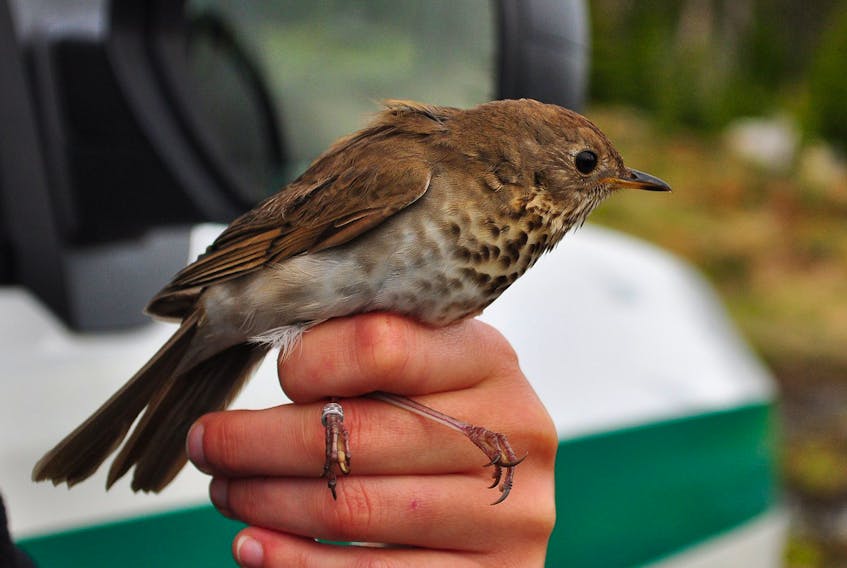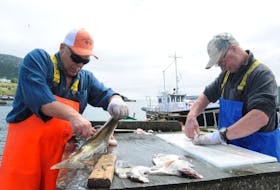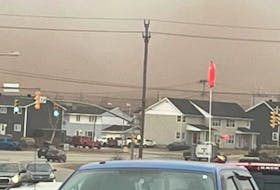Once as common as the robin, the gray-cheeked thrush has been listed under this province’s Endangered Species Act since 2015.
Scientists are still working to fully understand what happened to the songbirds, and what their future might hold. The future also means thinking about the uncertainties associated with global climate change.
The gray-cheeked thrush was one of the most commonly spotted birds during surveys in Newfoundland and Labrador in the 1970s.
Parks Canada ecosystem scientist and ornithologist Darroch Whitaker told The Telegram the local population then dropped by more than 95 per cent at lower elevations, all but disappearing.
He said it was only during the initial investigation that some of the birds were discovered again in patches — mainly at higher elevations — in Gros Morne National Park and in the Long Range Mountains.
Theories then emerged around both the rapid change in the numbers and distribution including: loss of habitat, predation on bird nests and increased deaths during migration and winters down South.
Whitaker said he committed to further research because the birds are part of the province’s unique natural heritage and have significance in terms of its biodiversity.
In fact, while gray-cheeked thrush are found in summer throughout the world’s boreal forest, the local population has returned to Newfoundland annually, with some in southern Labrador.
And for thousands of years and generations, with the returning birds not breeding with larger mainland populations and adapting to the particular environment, a genetically distinct, local population developed.
There has been a similar discovery of distinct genetics for more than 20 other bird species associated with the province.
“From a conservation point of view, we really do focus on those unique genetic units or population units within species and we do try and preserve those to maintain the overall biodiversity of species,” Whitaker said.
He teamed with Ian Warkentin, a professor in environmental science at Memorial University of Newfoundland (MUN), who also co-authored the “Birds of Newfoundland” field guide.
Their subsequent work confirmed the change in distribution and also used DNA testing to firm up the gray-cheeked thrush taxonomy. Through partners in the United States, blood and tissue samples from birds in Newfoundland, Labrador and Nova Scotia have wound up archived at New York State Museum.
Enter: the squirrel
The researchers also, “found that thrushes were greater than three times more likely to be detected at sites where squirrels were not observed,” according to a paper published in Avian Conservation and Ecology.
Red squirrels were introduced to the island of Newfoundland in the early 1960s and have spread out since, preying on songbird eggs and young.
And the gray-cheeked thrush is believed to have started declining in the 1970s.
Supervised by Warkentin, masters of science student Jenna McDermott has been providing more detail on where squirrels actually are now found in the province and examined any relationship between the thrushes and the squirrel.
“So I’m working in a sort of mountainous region that ranges in elevation from 75 metres to 600 metres, and the red squirrels only go up the mountains up to about 450 metres for the most part. Gray-cheeked thrush only start appearing above 350 metres,” she said, in an interview Friday.
“There’s only a very small overlap between where the two distributions are, and that sort of points towards red squirrels being a culprit here,” she said, adding she is still working through two years of data and observations, collected from over 2,000 individual points along the selected landscape.
Migratory bird, global concern
But the potential for the birds being affected by environmental change elsewhere is also being investigated.
McDermott has also spent time capturing gray-cheeked thrush outfitted with radio tags over the past couple of years, in order to gather data on where else the local birds might be stopping during their migrations and calling home in winter.
The limited data so far suggests they are remaining in a fairly compact area in winter, mainly in Columbia.
Warkentin explained this migratory connectivity.
“Our population from Newfoundland could well be going to a very small, confined area of maybe Columbia, Venezuela, as opposed to being scattered all the way across what we know of as the gray-cheeked thrush wintering range,” he said.
Warkentin — still investigating other potential influences on the local gray-cheeked thrush population — said, at this point, he’s not convinced winter threats are part of the answer to what caused the population retreat here, but this tracking work and investigation is really a part of understanding the migratory species.
In terms of climate change, it is a concern for migratory birds in general.
The New York Times reported in January, researchers have found birds moving between Europe and Africa, time their migrations to match up with availability of food, but also migrate in loops rather than direct lines, adjusting route and speed, factoring wind and weather. Over time, those wind conditions are expected to change.
In May, a Duke University-led study looked at how the timing and trajectory of the sooty tern migration placed it in the path of Atlantic hurricanes.
Increasing hurricane intensity with climate change becomes a risk to the birds as a result.
Whitaker said the potential for change in the habitat of the gray-cheeked thrush in Newfoundland and Labrador is a consideration.
The higher elevations where the birds are now found could become more hospitable to predatory squirrels over time, adding pressure on the thrushes.
However, this change is a slow process and the case is considered one where a better understanding of the recent past and current threats remain a primary concern.









